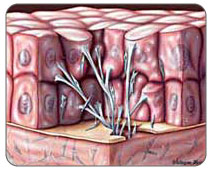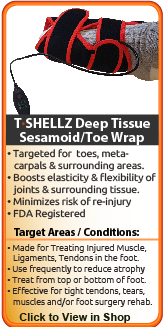|
|
What is Foot Tendonitis?Symptoms of Foot TendonitisYou might be suffering from a Posterior Tibial Tendon Injury if you have:
A Posterior Tibial tendon injury is usually caused by repetitive use of the tendons, but can also be caused by trauma such as a rolled or sprained ankle. Little tears in the tendon irritate the tendon fibers resulting in pain and inflammation, resulting in an inability to maintain strength along the tendon. Posterior Tibial tenosynovitis is swelling and inflammation of the tendons' sheath (or covering) which prevents the tendons from gliding smoothly within the sheaths, causing pain. It can be experienced at the same time of posterior tibial tendonitis, and has similar symptoms. It often results in trouble moving the ankle and will feel sore to the touch. In rare cases, tenosynovitis can be caused by infection, so it is always recommended to check with your doctor to rule this out as a cause. Tearing of the tendon is not uncommon. This leads to pain, swelling, sensitivity and a sense of instability in the ankle. The tendon(s) can also pop out of the supporting ligaments that hold them in place; this is known as a tendon dislocation. Who is Most at Risk of Foot Tendonitis?
What Causes Posterior Tibial TendonitisPeroneal tendonitis is the degeneration of the tendon tissue in the ankle. What causes our tendon to start to fall apart? 
Posterior Tibial Tendon Dislocation (subluxation) / Tearing or dislocation can happen in 1 or both of these tendons. This leads to pain, swelling, sensitivity and a sense of instability behind the outside of the ankle. They can also pop out of the supporting ligaments that hold them in place (a dislocation). After this happens you might repeatedly dislocate the tendons in your ankle and this tissue will tear even more without proper treatment. If you suffer from torn (ruptured) or dislocated peroneal tendons you might need stitches or even a tendon replacement to fix the problem. How Do I Diagnose Posterior Tibial TendonitisThe diagnosis of posterior tibial tendonitis is usually made by examination of the ankle. A physical check by your doctor will help to determine where the tendons are inflamed, ruptured, or degenerated. The doctor will move your ankle into different positions during a physical examination. These tendons are usually checked by using the single foot raise. Single Foot RaiseThe patient is asked to stand with full weight on the afflicted foot with the other foot in the air. At this point the patient is asked to raise up on their toes. If the tendon is attenuated or ruptured, the patient will be unable to do so. In cases of tendonitis or tendinosis, the patient may be able to do so but it will be painful. X-rays may be ordered to make sure there is no fracture or other problem with your fibula or the other bones in your ankle. Your doctor may order a magnetic resonance imaging (MRI) scan of your ankle. These images can show if there is abnormal swelling or scar tissue in the tendons. MRI scans can also show lengthwise tears in the tendons. Foot Tendon Injury Scar Tissue Growth Overuse or injury (direct trauma, a fall, an accident or rolling over on your ankle) will cause weakness and loss of range of motion in the ankle, and the tendons become irritated and inflamed. A posterior tibial tendon strain is kind of like taffy that has been overstretched until it becomes thin and eventually frays. The tendon tries to protect itself from this constant irritation by trying to repair the damaged tissue. During the healing process your body will automatically fill in tears in your tendons with dense, brittle tissue called "scar tissue". The human body will use scar tissue as a temporary healing solution and will try to build the scar tissue as fast as possible to heal tears in your peroneal tendons or posterior tibial tendon. Scar tissue can form fast to strengthen the damaged tendon, but working fast doesn't mean that the job's done right. When scar tissue forms it doesn't come together as neatly as regular (healthy) tendon tissue would. Scar tissue fibers will lay down over top of your tear in a cluttered, messy and jumbled up way.  This is how scar tissue works. The scar tissue that forms in and around your strained ankle tendons will be unorganized and won't line up properly with the healthy tissue surrounding the tear. This scar tissue will also attach to everything in and around your ankle including the surrounding healthy tissue as well. This can result in a long-term fusing together of your tendon with everything around it; this will definitely freeze up your ankle, severely reducing your mobility. Scar tissue is a weak form of collagen - hard, inflexible, and tough to get rid of once it begins to take hold. The more scar tissue that develops, the more you lose range of motion. With excess scar tissue build up, the injured soft tissue and the ankle in general will remain weak and prone to re-straining and re-tearing. While you can go a number of days and even a few weeks without any major setbacks during the injury.. inevitably, a certain movement or motion will happen that causes your injured soft tissue to strain and even tear once again. This is attributed to the scar tissue build up and will result in the buildup of yet more scar tissue and a further reduced range of motion (ROM). The more scar tissue that develops, the greater the risk of winding up permanently injured with chronic pain or arthritis. Scar tissue means that your joint will not perform as well as it once did and it makes it much more prone to injury later on. The longer the injury remains, the risk of atrophy increases and the risk of more scar tissue increases. This is why it is critical to treat your tendon injury now rather than later. Continuous re-injury and build-up of scar tissue makes it more likely that you will wind up with chronic pain, reduced Range of Motion or even arthritis (permanent damage).Nonsurgical Treatment for Posterior Tibial Tendonitis or Peroneal TendonitisIf you have a lot of pain you may need to have a walking boot or cast for 2 to 4 weeks. If there is no pain or tenderness with walking a stirrup ankle brace, arch support, or lateral heel wedge can help to take tension off of your injured tendons. In most cases, your Doctor will start with non-surgical treatments options. Some of the options your doctor may recommend include drugs or medications like NSAIDs (non-steroidal anti-inflammatory drugs) to manage pain and inflammation. Steroid injections are advised with caution for any type of tendon condition as there is increased risk of tendon rupture. Treating Posterior Tibial Tendonitis - What You Can Do!The good news is that most posterior tibial tendinitis injuries will heal with conservative treatments and surgery is often not needed! Read our tendinitis treatments page here. Foot Tendonitis Home Conservative Treatment Options!Step 1 - Reduce Pain and Swelling with Cold CompressionThe first step for conservative treatment of your foot tendonitis is to reduce the swelling to "open up" the area for more blood flow. Anyone in the health-care business knows that your blood supplies the oxygen and much needed nutrients required to heal foot tendonitis injuries. This is why for years, doctors, trainers, and other medical professionals have recommended RICE (Rest, Ice, Compression, Elevation) to treat the pain and swelling of fresh injuries, chronic pain, and after any re-injury. This is important because once blood vessels are blocked or damaged, they can no longer carry oxygenated blood to your damaged tendon and tissues begin to break-down. Without cold compression, tissues break down further because they can't get the oxygen they need to survive. By limiting the amount of damage done to your tendons, you also limit the amount of healing that needs to occur. This is a very important step to heal acute or chronic tendon injuries faster and with less pain! Use a Cold Compress or Ice Pack:
Stage 2: Focus on Increasing Blood Flow To The Injured Tissue - As This is The ONLY Way Soft Tissue Heals For the Long-TermEven though the concept is simple, improving blood flow to injured tissues can be difficult. When the injury is achilles related, the challenges are even greater. Traditional methods require your muscles and tendons to move to promote blood flow (exercise), but that same motion that promotes blood flow can at times lead to making your pain and condition worse.
Most people we deal with tell us these scenarios have happened to them many times in the past. Perhaps it has already happened to you. Promoting blood flow within a muscle or soft tissue injury to help the body heal itself is a concept that has been utilized for centuries. This is where the focus has to be if you are seeking long-term improvement. Oxygen and nutrients, carried within the blood, are critical for the body to heal itself. Without proper blood flow, recovering from an injury or condition will be delayed...sometimes for a very long period of time. The real challenge is how do you promote blood flow to the achilles injury site without causing further injury? This goal is further complicated by the fact the achilles (and muscles controlling the ankle joint) are involved every physical movement we perform each day if we are on our feet. An injury that often leads to straining in other areas will make an overall recovery hard to initiate. People tend to "chase the pain", meaning they only focus on treating an area that is actively painful, while not taking into account the fact they other areas of the body will be overcompensating...eventually leading to issues in those areas as well. Heat energy generated by the TShellz Wraps® operate by increasing blood flow in our injured soft tissue. This means ligaments, muscles, and tendons. The objective of the TShellz Wrap® is to increase blood flow in these targeted areas, resulting in relaxation of the vessel walls. The vessels then gently expand, allowing for more nutrient rich blood flow along with extra oxygen to reach the damaged tissues. Plus, the enhanced blood flow helps in flushing waste and fluid build-up from the injury site - further enhancing the ability of the body to heal. With a TShellz Wrap® application, more blood begins to flow in and around the area of treatment - for the length of the treatment and a short duration thereafter. Tissue needs the extra blood flow to heal as it is through the blood the body carries the oxygen and nutrients needed for proper and long-term healing. Increased Blood Circulation = Increased Healing CapabilityTShellz Wraps® contain a unique Carbon Fiber Energy Pad which is flexible and will shape to conform to your body. This Energy Pad emits a uniform wave of perfectly safe energy over its entire surface. This energy is absorbed by soft tissue in the treatment area, opening blood vessels, resulting in an increase in blood flow. Increased blood circulation is what your body needs to accelerate the healing of soft tissue and this is why we recommend the TShellz Wrap®. The TShellz Wrap® is an FDA Registered Medical Device and is suitable for use in therapeutic clinics and FROM HOME. It is completely safe for people and patients to use for themselves. The technology found in a TShellz Wrap® has been used for decades in the worlds of professional and amateur sports - a contributing factor as to why athletes seem to recover from injuries so quickly. Have you ever wondered by an athlete can return to activity after 3 or 4 weeks following a tendon injury - while your average person takes much longer to return back to normal? The secret isn't really that much of a secret - it involves consistent treatments (meaning multiple times a day) using a treatment like the TShellz Wrap® to stimulate blood flow to the injured tissues. Most athletes have the luxury of using in-house facilities many times per day. How many us can afford the time and money to visit a clinic multiple times a day? Very few indeed. This is how you can gain some of the advantages that athletes enjoy in their injury recovery - by using a device like the TShellz Wrap® two or three times a day on a consistent basis. Consistent Treatments = Consistent And Long Term ImprovementWhat Else Makes the TShellz Wrap® So Special?We believe the TShellz Wrap® to be one of the most effective home treatments to increase localized blood flow in and around the treatment area. We can promise that you will receive a product that is designed to be safe and does what it is supposed to do...quickly relieve pain and aid in the recovery from tendon, muscle and other soft tissue injuries. The unit plugs into a standard wall outlet to get its power. The nice thing about the power supply is that the same unit can be used in North America and overseas as well. It has the capability to operate between 110v and 230v. The TShellz Wrap® has a special signal controller that can be set for 3 different power levels of application (3=High, 2=Medium, 1=Low). The cord is long enough that you can sit or lie comfortably and watch TV, read or surf the net while you're using it. Treatments are max 30 minutes in duration and the device can be worn over clothing. This allows you to use the device at work, at home, or really anywhere you have access to an electrical outlet. A Recap of the Benefits of the TShellz Wrap®..
When Should I Use My TShellz Wrap® During the Day?The most common question we receive from individuals prior to purchasing is - how many times a day should I be using my wrap and when should I be using them? While treatment plans will differ for each individual and their specific injury, there are general guidelines that should be adhered to.
The TShellz Wrap® would then be used:
Step 3 - Stretch Your Foot to Speed Up RecoveryThe final step in foot tendonitis recovery is stretching - this is a critical step for complete recovery from your injury! Physical therapists almost always prescribe gentle stretching for to deal with foot tendonitis, and if no device is available, they usually prescribe something called "heel slides". In a clinic, your PT will help you to perform a heel slide if your foot hurts too much to do it on your own. Outside of the clinic (when trying this stretch at home), your PT might suggest that you try to use a plastic bag, cookie sheet, tension band, belt or any other household tool to help you move your foot. You'll find in most rehabilitation programs heel slide stretching and conservative treatment will help to:
Use These Conservative Treatment Tools |
         |







